Abstract
The relationship of lectin-dependent cell-mediated cytotoxicity (LDCC) to interleukin-2 (IL-2) production was studied in healthy subjects and in patients with systemic lupus erythematosus (SLE). Profoundly depressed levels of LDCC were elicited by peripheral blood mononuclear cells (PBMC) from nine patients with active SLE in comparison to LDCC from seven controls, and eleven inactive SLE donors, using 3H-TdR-prelabelled adherent HEP-2 cells as targets in a 24 h assay with 25 micrograms/ml Con A. In parallel experiments, no individual correlation was found between LDCC activity and IL-2 production for healthy or SLE subjects. Further, no major differences were detected in IL-2 release when the three groups of donors were compared, a tendency observed at the Con A doses (5 and 25 micrograms/ml) and incubation times (24, 48, and 72 h) used to induce IL-2 production. In additional studies, impaired Con A-induced blastogenesis was noted for PBMC from active SLE patients in comparison to the PBMC from the controls or patients with inactive SLE. While strong individual correlation was obtained between blastogenesis and IL-2 secretion in controls and patients with inactive SLE, no such relationship was found in patients with active SLE. While addition of exogenous IL-2 to the cytotoxicity assay considerably enhanced LDCC by healthy donors it failed to improve LDCC by patients with active SLE. These data suggest that depressed LDCC and Con A-induced blastogenesis of patients with active SLE may not be related to impaired IL-2 production but rather to an inherent dysfunction of the effector lymphocytes, including their unresponsiveness to IL-2.
Full text
PDF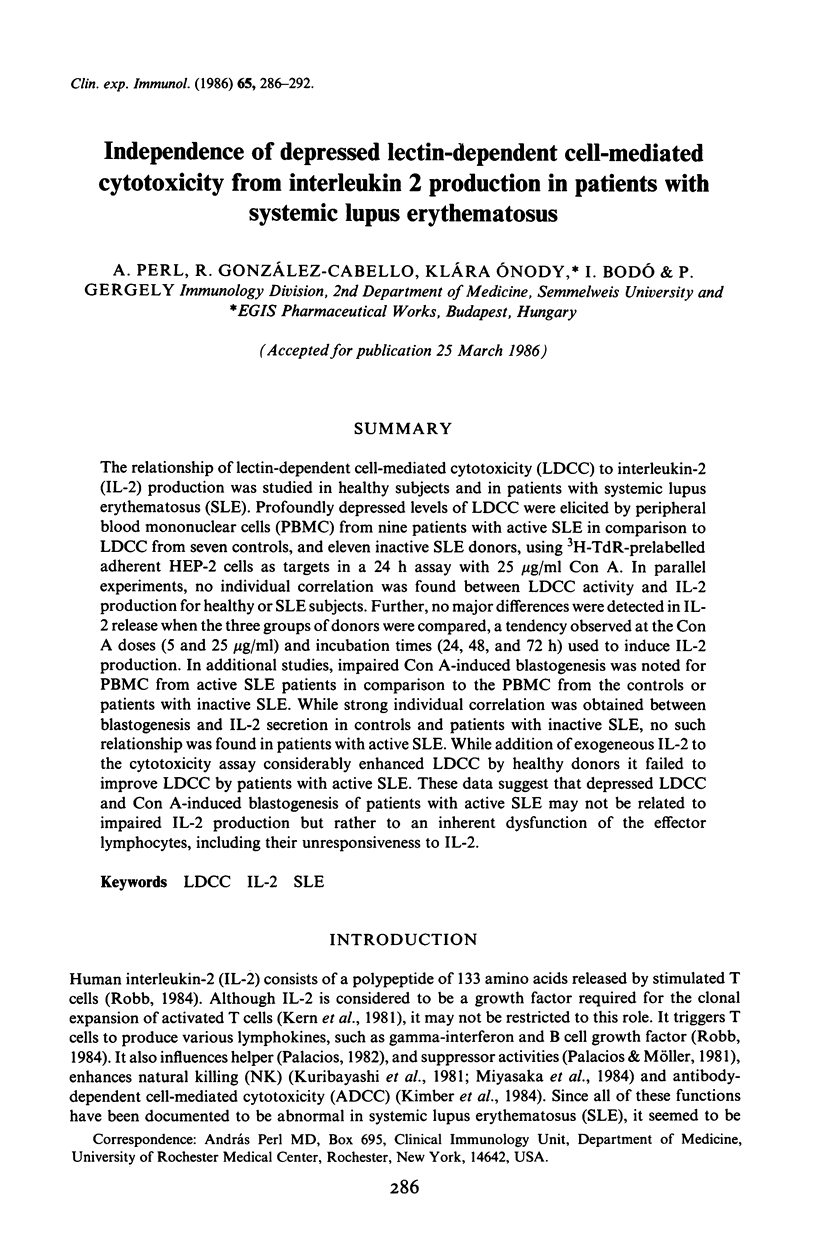
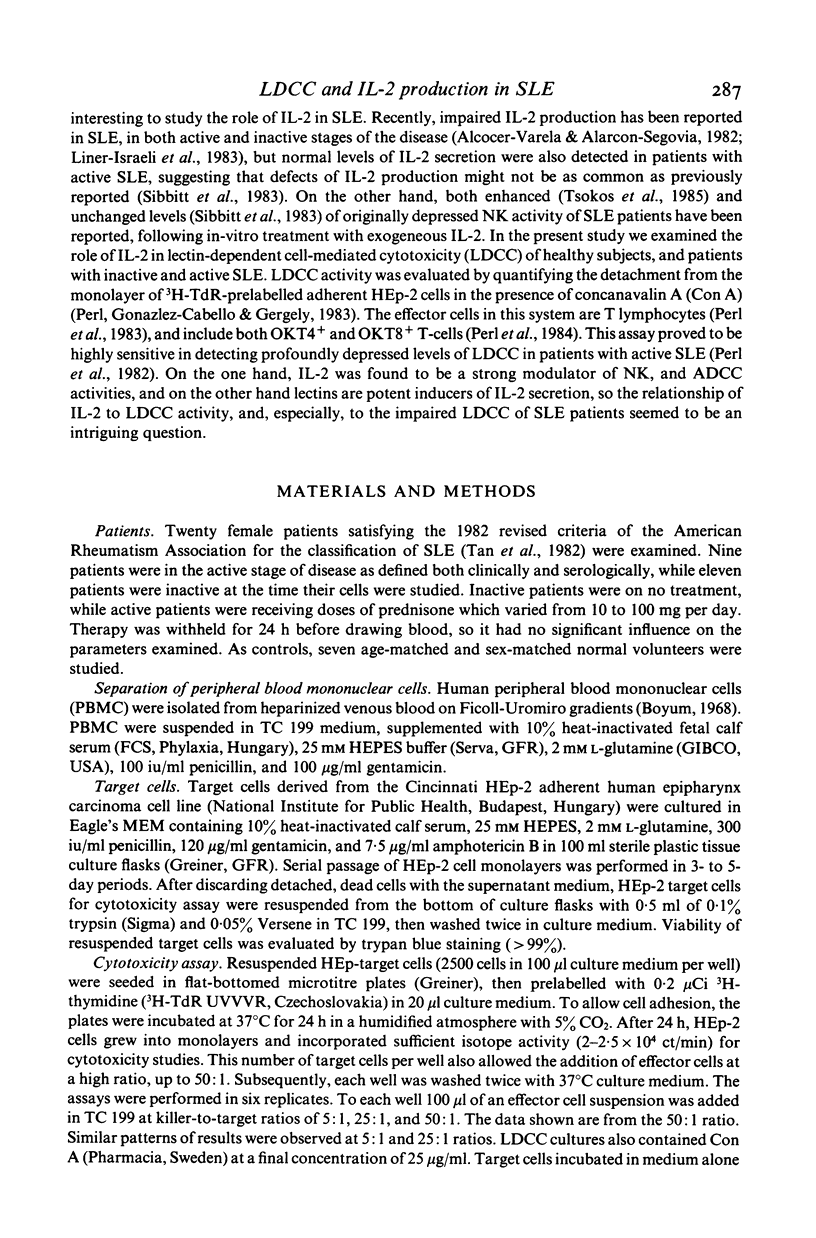
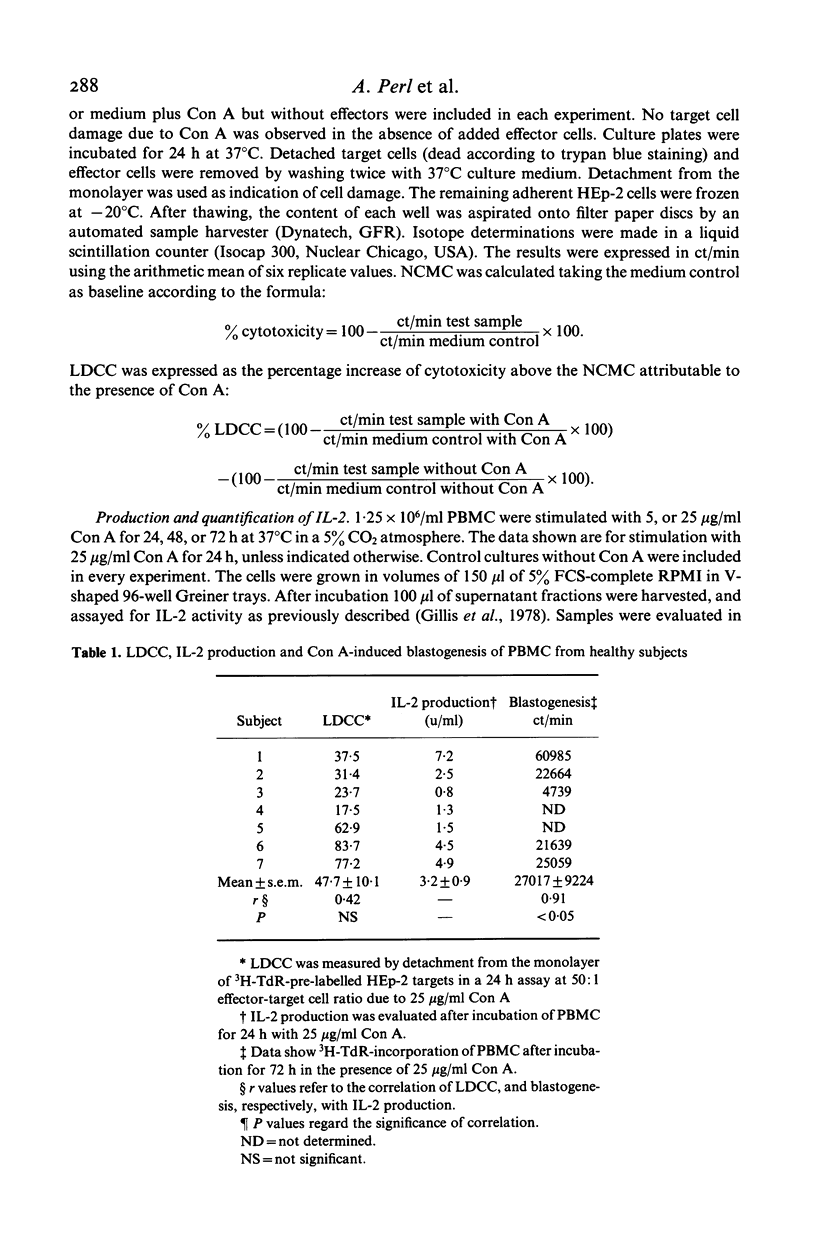
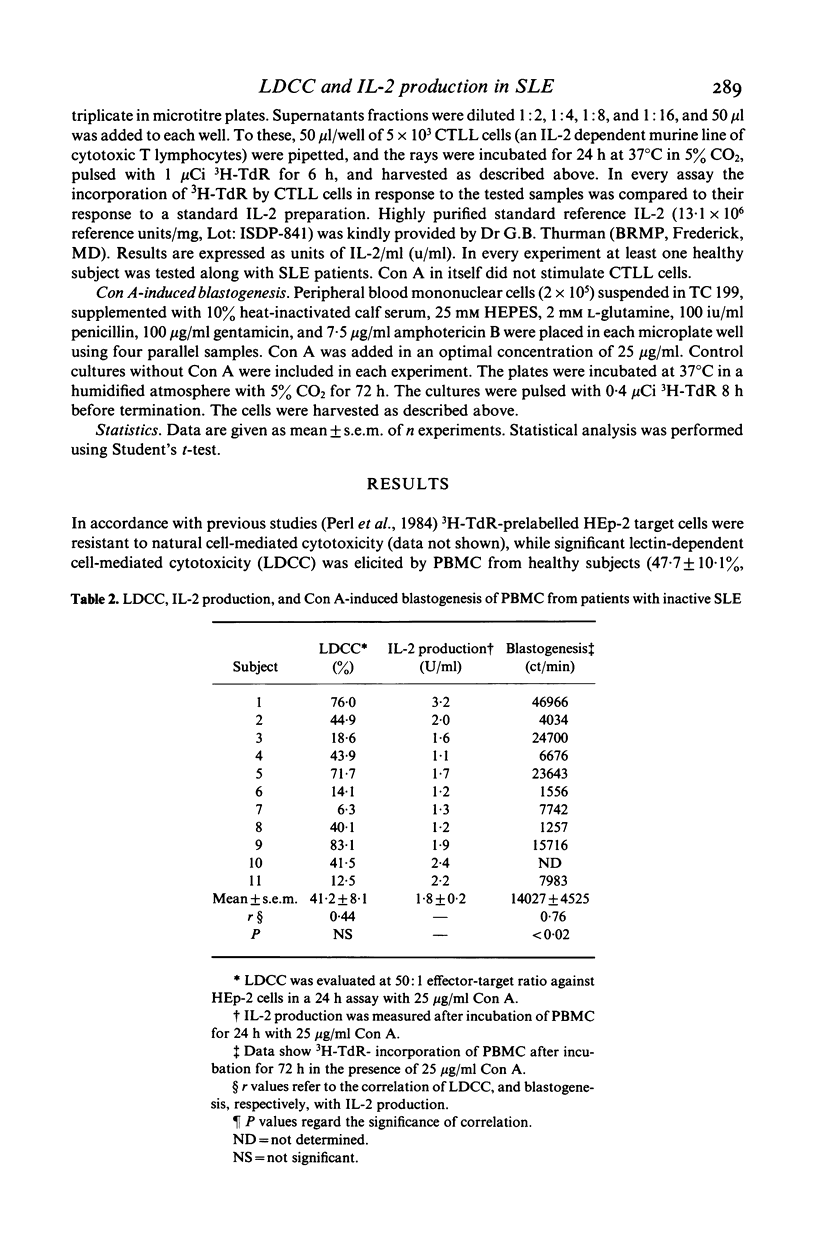
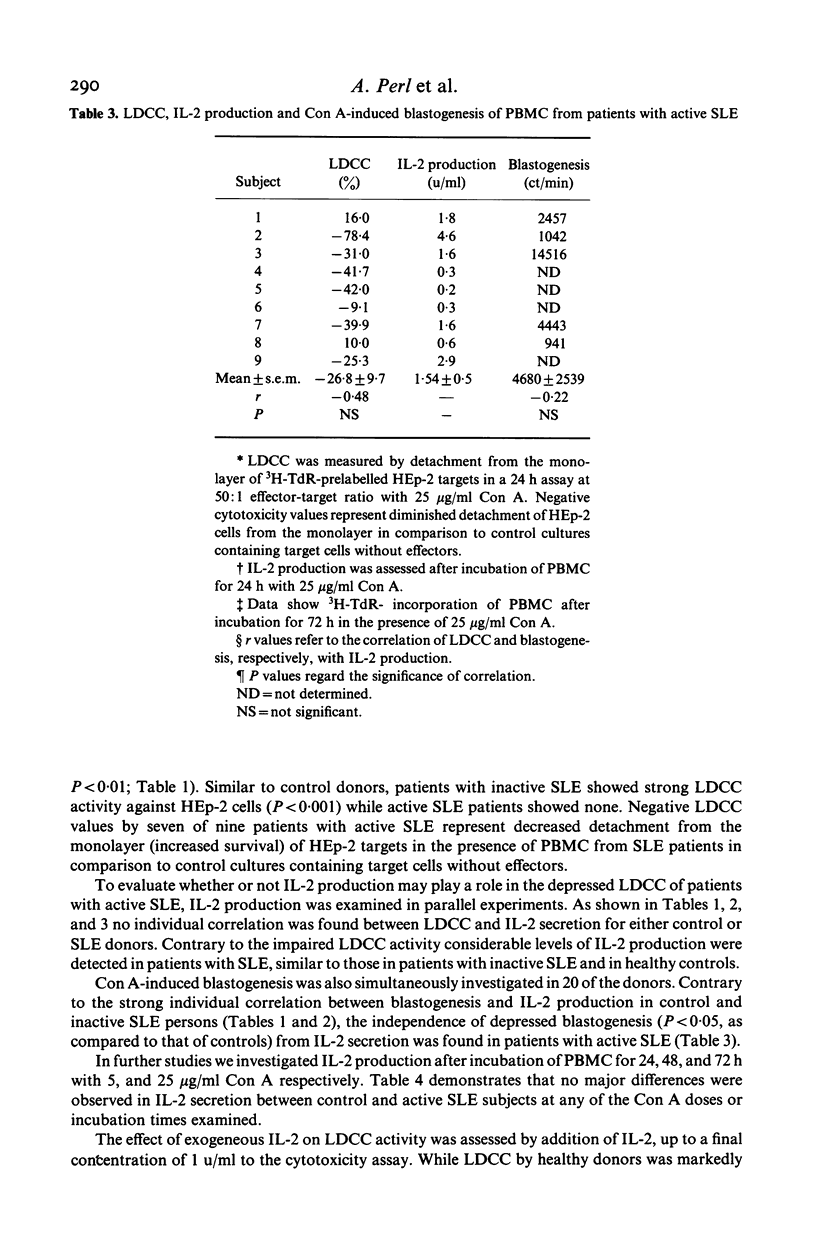
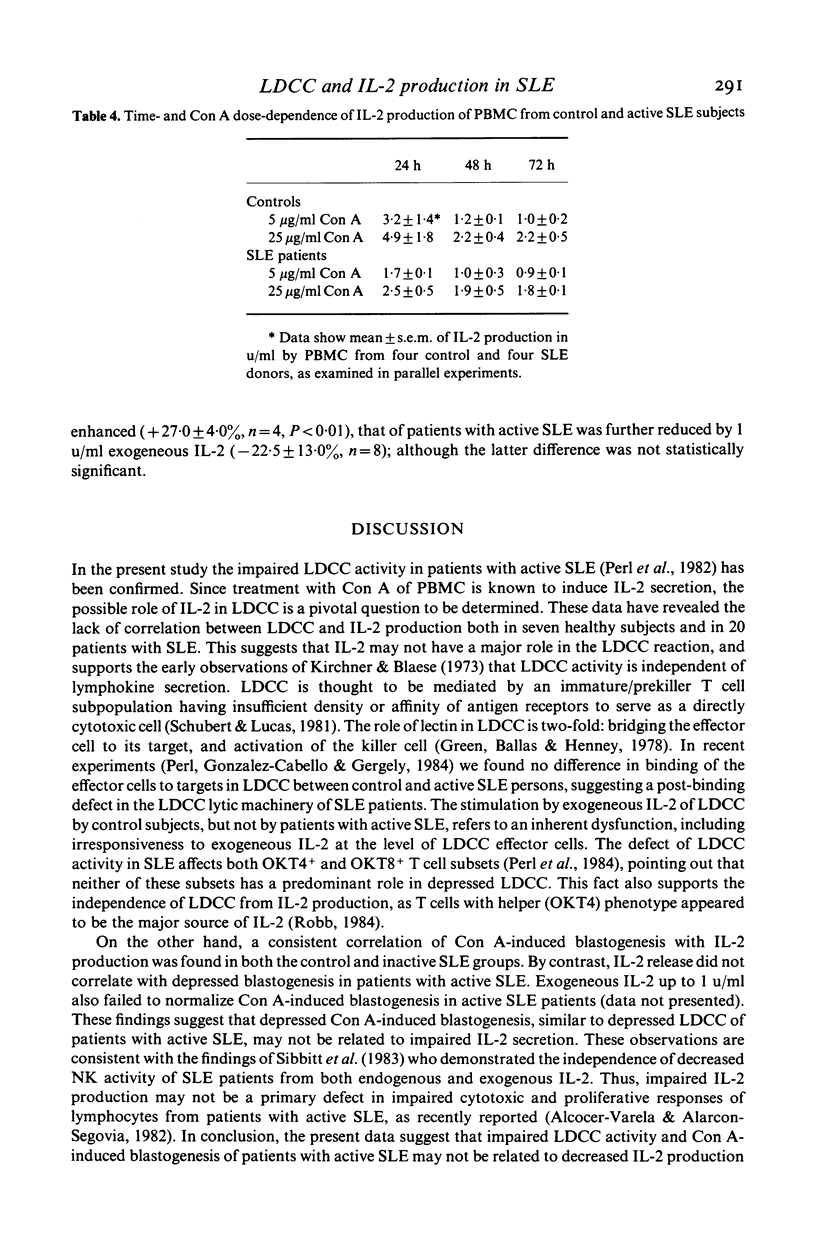
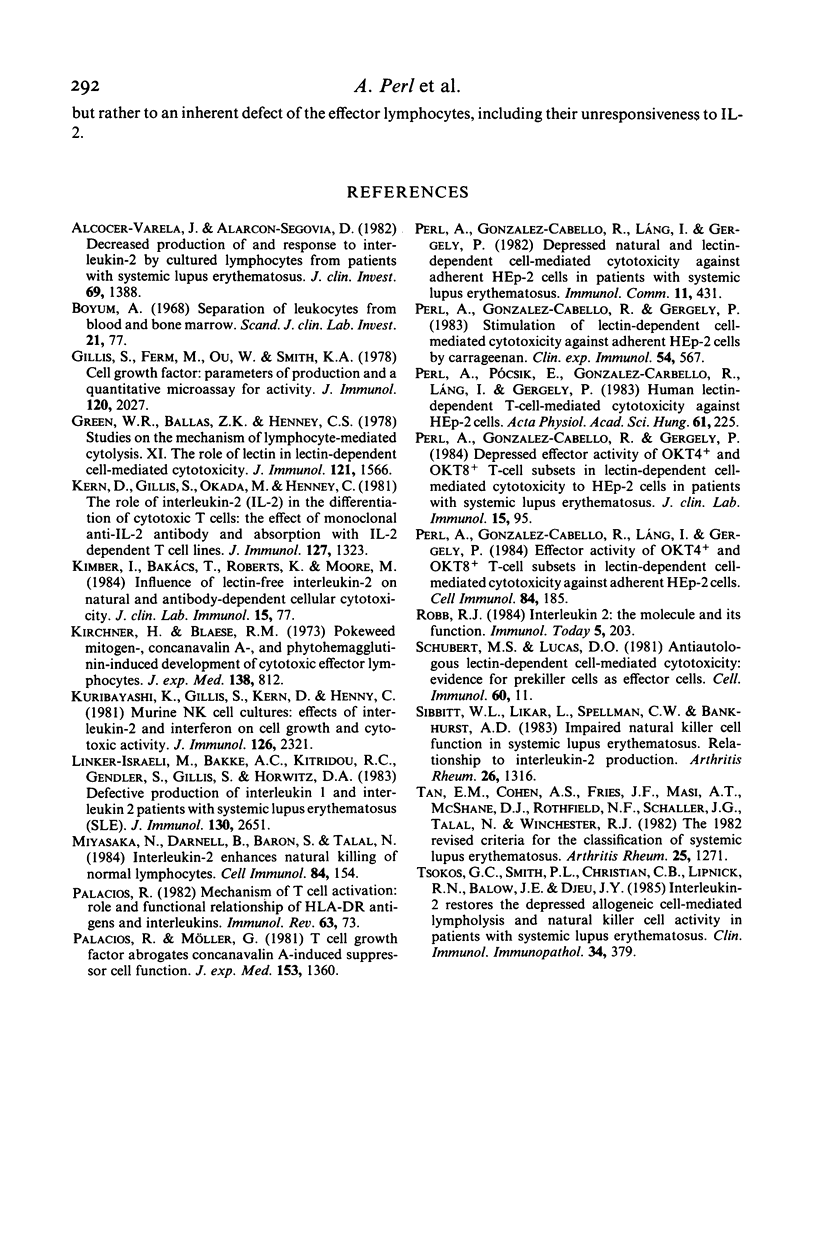
Selected References
These references are in PubMed. This may not be the complete list of references from this article.
- Alcocer-Varela J., Alarcón-Segovia D. Decreased production of and response to interleukin-2 by cultured lymphocytes from patients with systemic lupus erythematosus. J Clin Invest. 1982 Jun;69(6):1388–1392. doi: 10.1172/JCI110579. [DOI] [PMC free article] [PubMed] [Google Scholar]
- Gillis S., Ferm M. M., Ou W., Smith K. A. T cell growth factor: parameters of production and a quantitative microassay for activity. J Immunol. 1978 Jun;120(6):2027–2032. [PubMed] [Google Scholar]
- Green W. R., Ballas Z. K., Henney C. S. Studies on the mechanism of lymphocyte-mediated cytolysis. XI. The role of lectin in lectin-dependent cell-mediated cytotoxicity. J Immunol. 1978 Oct;121(4):1566–1572. [PubMed] [Google Scholar]
- Kern D. E., Gillis S., Okada M., Henney C. S. The role of interleukin-2 (IL-2) in the differentiatin of cytotoxic T cells: the effect of monoclonal anti-IL-2 antibody and absorption with IL-2 dependent T cell lines. J Immunol. 1981 Oct;127(4):1323–1328. [PubMed] [Google Scholar]
- Kimber I., Bakács T., Roberts K., Moore M. Influence of lectin-free interleukin-2 on natural and antibody-dependent cellular cytotoxicity. J Clin Lab Immunol. 1984 Oct;15(2):77–84. [PubMed] [Google Scholar]
- Kirchner H., Blaese R. M. Pokeweed mitogen-, concanavalin A-, and phytohemagglutinin-induced development of cytotoxic effector lymphocytes. An evaluation of the mechanisms of T cell-mediated cytotoxicity. J Exp Med. 1973 Oct 1;138(4):812–824. doi: 10.1084/jem.138.4.812. [DOI] [PMC free article] [PubMed] [Google Scholar]
- Kuribayashi K., Gillis S., Kern D. E., Henney C. S. Murine NK cell cultures: effects of interleukin-2 and interferon on cell growth and cytotoxic reactivity. J Immunol. 1981 Jun;126(6):2321–2327. [PubMed] [Google Scholar]
- Linker-Israeli M., Bakke A. C., Kitridou R. C., Gendler S., Gillis S., Horwitz D. A. Defective production of interleukin 1 and interleukin 2 in patients with systemic lupus erythematosus (SLE). J Immunol. 1983 Jun;130(6):2651–2655. [PubMed] [Google Scholar]
- Miyasaka N., Darnell B., Baron S., Talal N. Interleukin 2 enhances natural killing of normal lymphocytes. Cell Immunol. 1984 Mar;84(1):154–162. doi: 10.1016/0008-8749(84)90086-8. [DOI] [PubMed] [Google Scholar]
- Mogensen C. E. The glomerular permeability determined by dextran clearance using Sephadex gel filtration. Scand J Clin Lab Invest. 1968;21(1):77–82. doi: 10.3109/00365516809076979. [DOI] [PubMed] [Google Scholar]
- Palacios R. Mechanism of T cell activation: role and functional relationship of HLA-DR antigens and interleukins. Immunol Rev. 1982;63:73–110. doi: 10.1111/j.1600-065x.1982.tb00412.x. [DOI] [PubMed] [Google Scholar]
- Palacios R., Möller G. T cell growth factor abrogates concanavalin A-induced suppressor cell function. J Exp Med. 1981 May 1;153(5):1360–1365. doi: 10.1084/jem.153.5.1360. [DOI] [PMC free article] [PubMed] [Google Scholar]
- Perl A., Gonzalez-Cabello R., Gergely P. Depressed effector activity of OKT4+ and OKT8+ T cell subsets in lectin-dependent cell-mediated cytotoxicity to HEP-2 cells in patients with systemic lupus erythematosus. J Clin Lab Immunol. 1984 Oct;15(2):95–100. [PubMed] [Google Scholar]
- Perl A., Gonzalez-Cabello R., Gergely P. Stimulation of lectin-dependent cell-mediated cytotoxicity against adherent HEp-2 cells by carrageenan. Clin Exp Immunol. 1983 Nov;54(2):567–572. [PMC free article] [PubMed] [Google Scholar]
- Perl A., Gonzalez-Cabello R., Láng I., Gergely P. Effector activity of OKT4+ and OKT8+ T-cell subsets in lectin-dependent cell-mediated cytotoxicity against adherent HEp-2 cells. Cell Immunol. 1984 Mar;84(1):185–193. doi: 10.1016/0008-8749(84)90089-3. [DOI] [PubMed] [Google Scholar]
- Perl A., Pócsik E., Gonzalez-Cabello R., Láng I., Gergely P. Human lectin-dependent T cell-mediated cytotoxicity against Hep-2 cells. Acta Physiol Hung. 1983;61(4):225–231. [PubMed] [Google Scholar]
- Schubert M. S., Lucas D. O. Antiautologous lectin-dependent cell-mediated cytotoxicity: evidence for prekiller cells as effector cells. Cell Immunol. 1981 May 1;60(1):11–23. doi: 10.1016/0008-8749(81)90243-4. [DOI] [PubMed] [Google Scholar]
- Sibbitt W. L., Jr, Likar L., Spellman C. W., Bankhurst A. D. Impaired natural killer cell function in systemic lupus erythematosus. Relationship to interleukin-2 production. Arthritis Rheum. 1983 Nov;26(11):1316–1320. doi: 10.1002/art.1780261103. [DOI] [PubMed] [Google Scholar]
- Tan E. M., Cohen A. S., Fries J. F., Masi A. T., McShane D. J., Rothfield N. F., Schaller J. G., Talal N., Winchester R. J. The 1982 revised criteria for the classification of systemic lupus erythematosus. Arthritis Rheum. 1982 Nov;25(11):1271–1277. doi: 10.1002/art.1780251101. [DOI] [PubMed] [Google Scholar]
- Tsokos G. C., Smith P. L., Christian C. B., Lipnick R. N., Balow J. E., Djeu J. Y. Interleukin-2 restores the depressed allogeneic cell-mediated lympholysis and natural killer cell activity in patients with systemic lupus erythematosus. Clin Immunol Immunopathol. 1985 Mar;34(3):379–386. doi: 10.1016/0090-1229(85)90186-2. [DOI] [PubMed] [Google Scholar]


